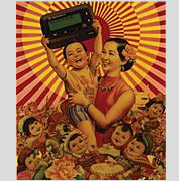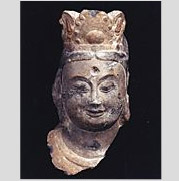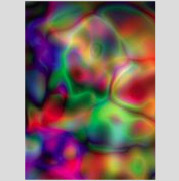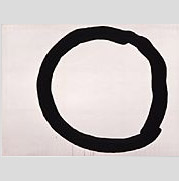 |
The Mori Art Museum will open on 18 October 2003 on the 52nd and 53rd floors of Tokyoユs Roppongi Hills Mori Tower. The Museum's primary aim is to mediate between contemporary art and as broad a public as possible by illuminating the links between art and life. Its inaugural exhibition will embark on this by casting a fresh eye on the familiar and universal theme of happiness.
Happiness is one of the most universal of human emotions; it has found expression in the art of all cultures and ages and has also been depicted in many diverse ways - some works bring a smile to our lips, while others make us think about what it all means. "Happiness: a survival guide for art and life" explores this eternal and elusive theme in Eastern and Western art from ancient times through to the present. It begins with human endeavors - maps of the world - and then moves through four different provinces of happiness - "Arcadia", "Nirvana", "Harmony", and "Desire" - before concluding its journey with paintings of the stars, the infinite, immeasurable spaces of the Universe.
Artists represented in the exhibition include Ito Jakuchu, Claude Monet, Paul Céanne, Henri Matisse, Pablo Picasso, Andy Warhol, Louise Bourgeois, Kusama Yayoi, Yoko Ono, Araki Nobuyoshi, Murakami Takashi and Jeff Koons.* Featuring around 250 works by roughly 180 artists, the work in the exhibition traverses Japanese and Asian Classical art from the 6th Century to the 19th Century, early Western modern art, including Romanticism and Impressionism right up to contemporary art made throughout the world today. A number of new works have been specially commissioned for this exhibition that is one of the largest ever to contain such diverse genres on a single theme. It has been co-curated by Mori Art Museum Director David Elliott, the first non-Japanese museum director in Japan, with Italian guest curator Pier Luigi Tazzi; Yamashita Yuji has advised on aspects of early Japanese art.
As well as giving us the opportunity of experiencing first-rate works of art, the exhibition asks some basic questions of us all. What does happiness mean today? How may we enjoy ourselves and achieve happiness in an imperfect world? Art is a reflection of our world, through which we can contemplate what is really important to us. In this way it can help us survive, and if we are lucky, also become happy.
|
|
* Please note that in Mori Art Museum publications the names of Japanese artists, with the exception of Yoko Ono, are given in traditional order, surname first.
|
 |
 |
ARCADIA
The essence of paradise is the abundance of happiness; it is from this point - the quest for different kinds of utopia -that the search for happiness begins. The possibility of a paradise on earth is reflected here in a variety of works related to personal, social and political ideals based on the Enlightenment principle that the pursuit of happiness is a fundamental human right. |
Among the artists represented in this section are John Constable, Paul Gauguin, Edouard Manet, Henri Matisse, Pablo Picasso, Henry Moore, Araki Nobuyoshi, Choi Jeong-Hwa, Peter Doig, Öyvind Fahlström, Gilbert and George, Dan Graham, Daniel Guzmán, Richard Hamilton, Ilya Kabakov, Kawamata Tadashi, Remo Salvadori, Cy Twombly.
Luo Brothers, I love Tienanmen Square, Beijing (1996-97).
Photograph, computer graphics, water color and lacquer on board.
Collection of Fukuoka Asian Art Museum. Photo courtesy of Fukuoka Asian Art Museum.
|
|
|
|
 |
 |
NIRVANA
The second idea of happiness is Nirvana. Consisting predominantly of Buddhist sculpture, sublime landscapes and abstract paintings, including work by J.W.M. Turner, James Lee Byars, Anish Kapoor, Yves Klein, Kusama Yayoi, Lee U Fan, Agnes Martin, Ad Reinhardt, Robert Ryman and Sugimoto Hiroshi, this section focuses on the immaterial, the metaphysical and the sublime,
|
with references to the spiritual sensation of euphoria and sense of awe when faced by the vastness of the universe.
China, Northern Qi, Bodhisattva (550-570) Lime stone.
Collection of London Gallery, Tajima Mitsuru.
Photo courtesy of London Gallery.
|
|
|
|
 |
 |
DESIRE
Exploring the realm of individual desire, this section focuses on drives and appetites, consumption and satisfaction. As the works here demonstrate, including examples by Peter Blake, Marlene Dumas, Tracey Emin, Philip Guston, Carsten Höer, Chris Ofili and Tom Wesselmann, desire may be unresolved or gratified and feeds off its own impetus.
Thomas Ruff, Substrate 6 II (2003) Ink-jet print. Collection of Gallery Koyanagi, Tokyo. Photo courtesy of Gallery Koyanagi.
|
|
|
|
 |
 |
HARMONY
The fourth and final idea is that of Harmony, which allows the quest and attainment of happiness to continue. Artists featured, including Ito Jakuchu, Joseph Beuys, Vija Celmins, Peter Kinley, Bruce Nauman, Yoko Ono, Giulio Paulini, Fred Tomaselli and Yoshiwara Jiro, address the notion of balance and stability in a world where different languages, values and ways of thought must co-exist to enable survival.
|
In one sense this is a realm of applied aesthetics in which art is concerned with making things whole, in another it is a prognosis for the continuation of civilized values.
Yoshiwara Jiro, Untitled (Black Circle on White) (1967) Oil on Canvas.
Collection of Ashiya City Museum of Art & History.
Photo courtesy of Ashiya City Museum of Art & History.
|
|
|
|
| ↑PAGE TOP |

Wesselmann, Tom
Great American Nude #50
1963
122 x 91.4 x 7.6 cm
Kimiko & John Powers Collection
Photo: See Spot Run Inc., Photo courtesy Gagosian Gallery, New York
Copyright Tom Wesselmann / VAGA, New York & SPDA, Tokyo, 2003
|
|
|



